Cook a juicy, tender New York strip steak at home the easy way — pan sear for flavor, then finish in the oven for the best steakhouse-quality results every time.
⏱️ Quick Answer: How Long to Finish a New York Strip Steak in the Oven
After searing for about 4 minutes total, finish a 1-inch New York strip steak in a 400°F convection oven (or 425°F regular) for 5–7 minutes for medium-rare or 7–9 minutes for medium — always check early.
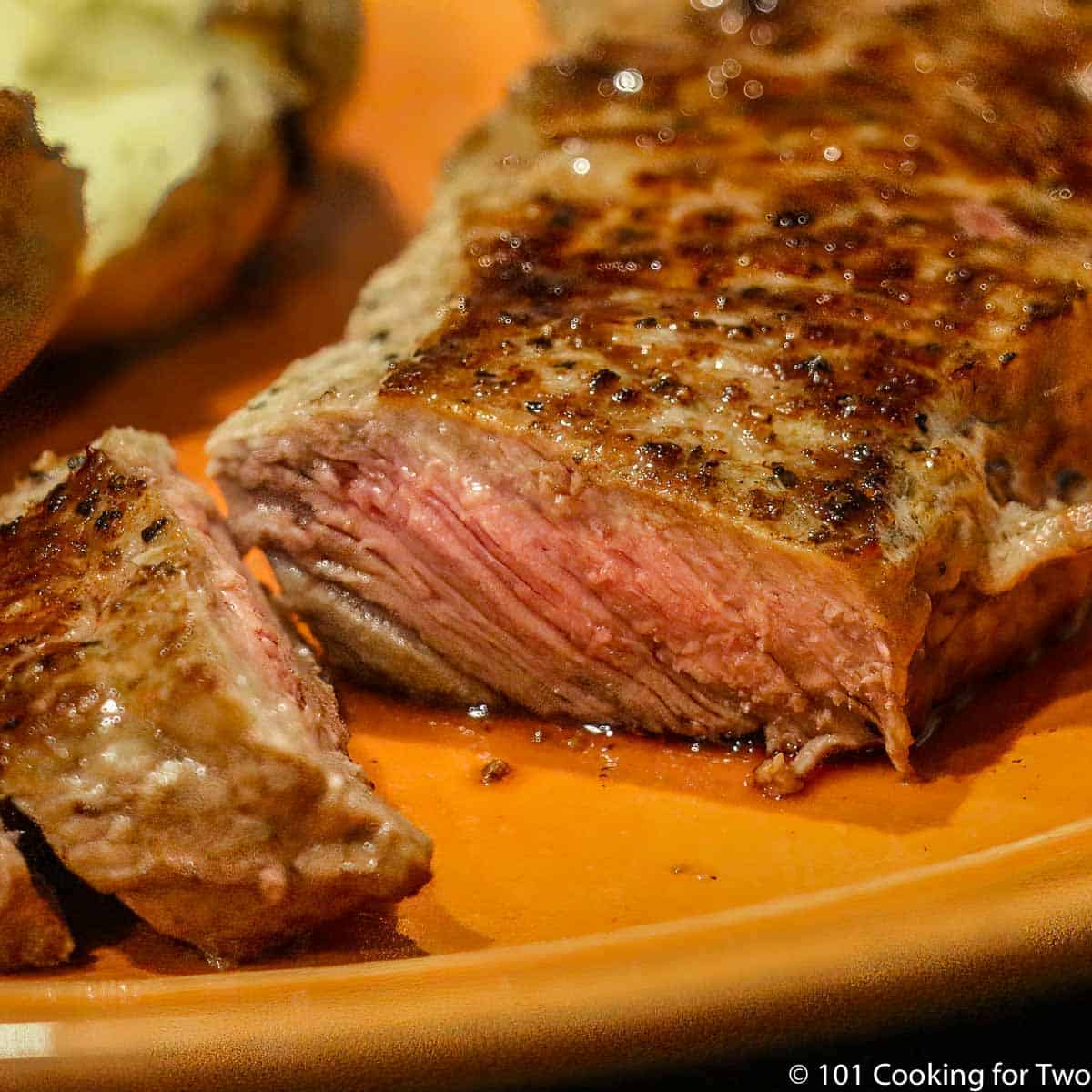
Jump To (scroll for more)
- 🧡 Why You’ll Love This Recipe
- 🥩 Ingredients and Seasoning
- 👨🍳Quick Overview: How to Cook a New York Strip Steak
- ⏰ How Long to Cook Strip Steaks in the Oven
- 🔧 Oven Temperature & Timing Tips
- 👍 Tips for Cooking Strip Steaks Right Every Time
- 🥩 Related Steak Recipes
- 🥔 What to Serve with New York Strip Steak
- ❄️ Storage and Reheating Leftovers
- ❓ FAQs
- 📖The Recipe Card
Featured Comment by Colleen:
⭐⭐⭐⭐⭐
"I made this for my family tonight. I got 5 STARS from even the pickiest eater"
🧡 Why You’ll Love This Recipe
- Juicy and tender every time — the easy pan-sear, oven-finish method.
- Better than the grill (for some): The pan gives you that crusty sear, and the oven keeps it juicy without flare-ups.
- Cooked to the perfect doneness: Whether it’s rare or medium-well, you’re in control with this method.
- Made for home cooks: No special gear needed — just a good pan and a little confidence.
🥩 Ingredients and Seasoning
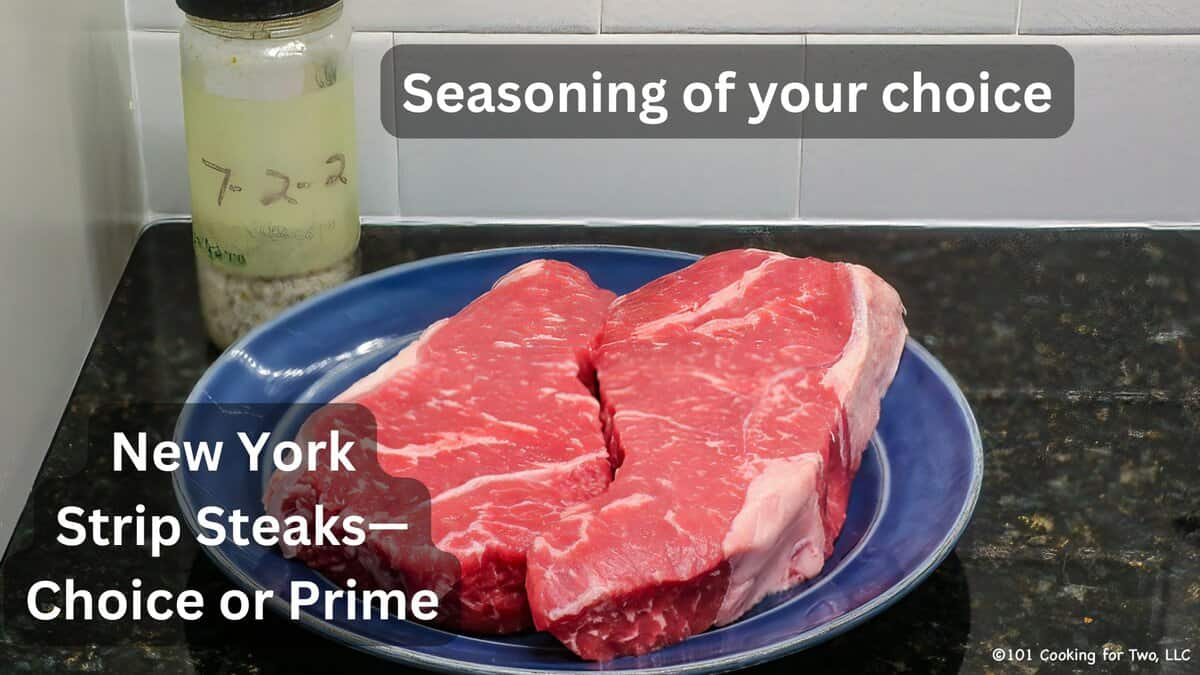
What you need
- New York strip steaks — About 1 inch thick, Choice or Prime grade. Also called strip steaks, Kansas City strip steaks, or striploin.
- Salt and pepper — Coarse kosher salt and black pepper are all you really need.
Optional seasonings
- Add a bit of garlic powder (or use my [7:2:2 seasoning mix] for extra flavor).
- Try commercial steak seasonings like Montreal Steak Seasoning.
- Fresh or dried herbs like thyme or rosemary can add a nice touch.
- For a flavor twist, use a dry rub (like coffee rub) or a steak marinade if you plan ahead.
👨🍳Quick Overview: How to Cook a New York Strip Steak
Here’s the simple classic pan-sear, oven-finish method that gives you juicy, tender results.
1. Trim and season:
Let steaks rest at room temp for 15–30 minutes if you have time. Trim fat, pat dry, and season with salt, pepper, or your favorite steak seasoning.
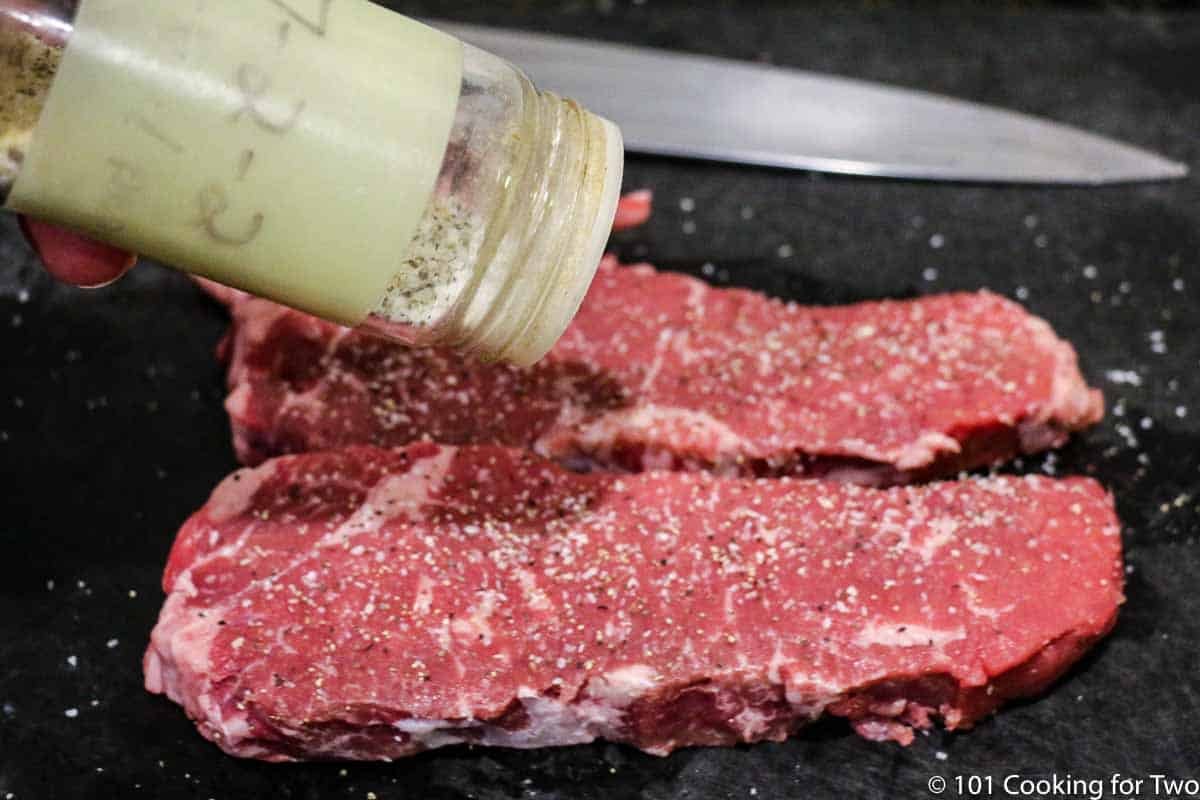
✅ Pro Tip: For the juiciest steak, season with salt either right before searing or at least an hour ahead. Salt pulls moisture at first, but given time, it reabsorbs and helps flavor the meat from within.
2. Pan sear for flavor:
Heat a cast iron or oven-safe skillet over medium-high. Add butter or oil, then sear both sides for about 2 minutes per side until you get a deep brown crust.
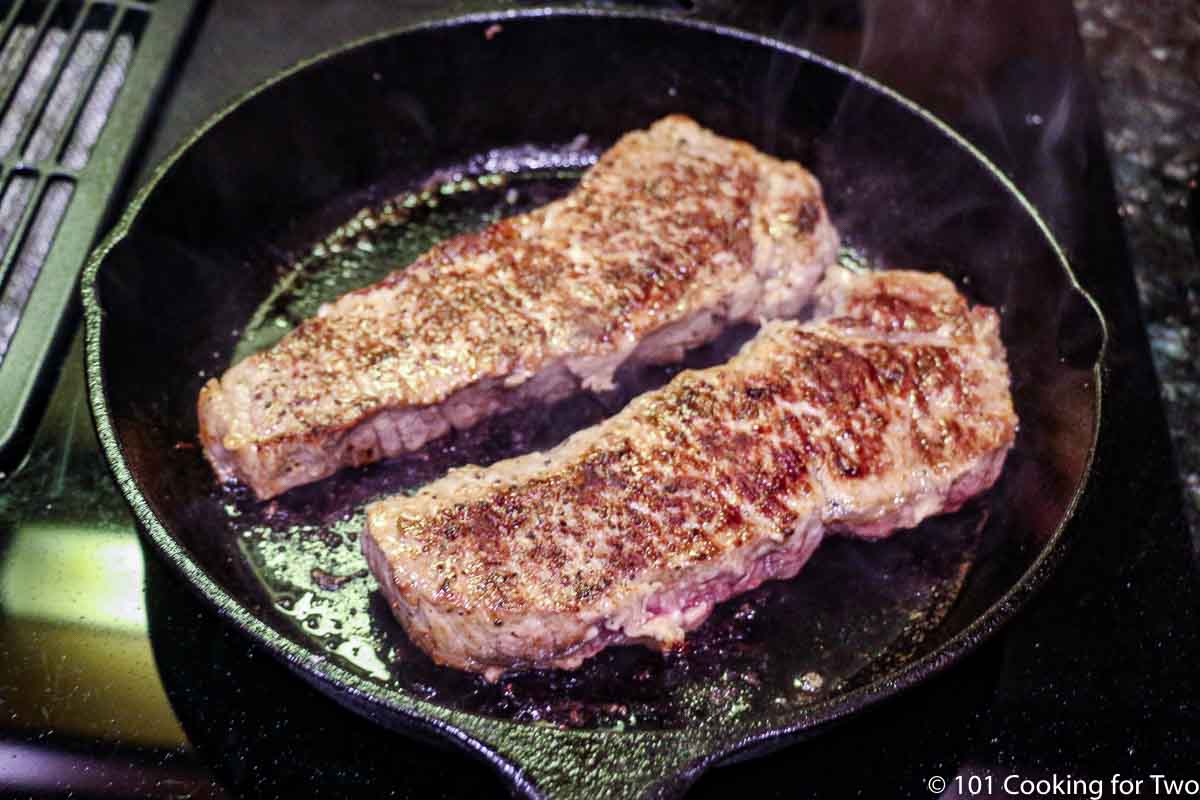
✅ Pro Tip: Flip once more right before transferring—this helps even out the crust and reduces the risk of overcooking.
3. Finish steak in the oven:
Move the skillet to a 400°F convection (425°F regular) oven. Roast 5–7 minutes for medium-rare, 7–9 minutes for medium.
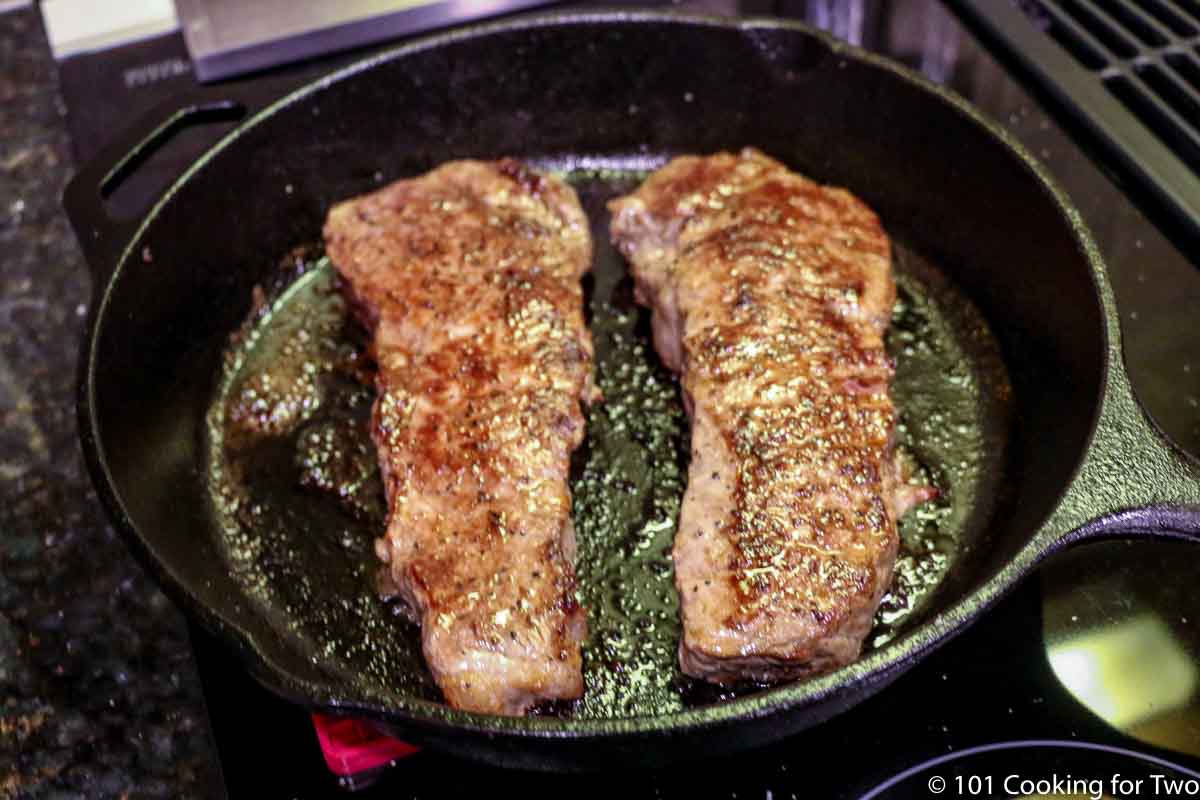
✅ Pro Tip: Pull the steak 3–5° before your target temp—carryover cooking finishes it perfectly.
4. Rest before serving:
Tent loosely with foil and rest 5 minutes before slicing. This keeps the juices where they belong—inside the steak.
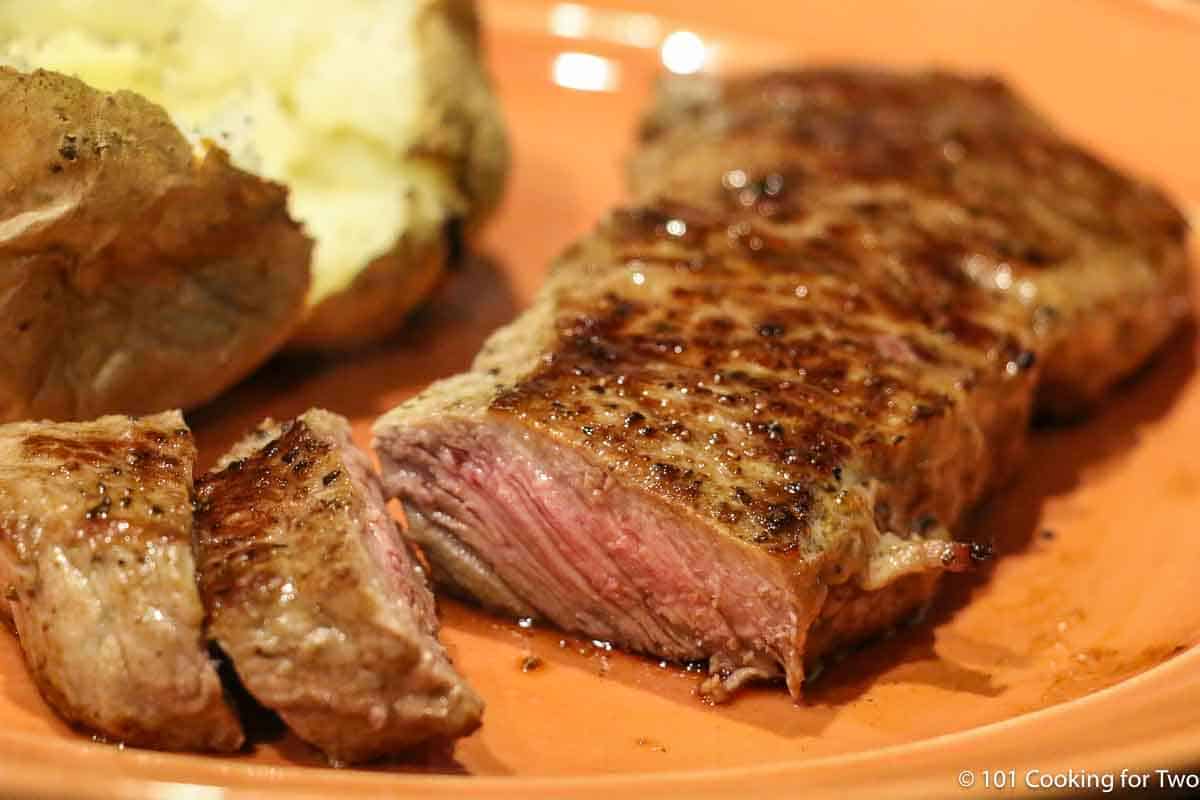
📌 For full step-by-step instructions, scroll to the printable recipe card or keep reading for pro tips, seasoning ideas, and sides.
⏰ How Long to Cook Strip Steaks in the Oven
All total times include about 4 minutes of pan-searing before finishing in the oven at 400°F convection (or 425°F regular).
- Rare (125°–130°F): 2–4 minutes in the oven for a total of 6–8 minutes
- Medium-rare (130°–135°F): 5–7 minutes in the oven for a total of 9–11 minutes
- Medium (140°–145°F): 7–9 minutes in the oven for a total of 11–13 minutes
- Medium-well (150°–155°F): 9–11 minutes in the oven for a total of 13–15 minutes
- Well done (160°+): 12–15 minutes in the oven for a total of 16–19 minutes
✅ Pro Tip: Always cook to internal temperature — not just time. Pull the steak 3–5° early for carryover cooking.
Save this recipe!
🔧 Oven Temperature & Timing Tips
- Best oven temperature: 400°F convection (or 425°F regular) gives the best crust and juicy center.
- Other oven temp options: 350°F or 375°F will work but need longer oven time — check early.
- What affects timing: Oven accuracy, steak thickness, sear time, and starting temperature all change how long it takes in the oven.
👍 Tips for Cooking Strip Steaks Right Every Time
- Start with quality beef: Prime or Choice grade strip steaks are the most tender and flavorful.
- Right thickness matters: This method works best for steaks between ¾ and 1½ inches thick. Thicker cuts need a reverse sear.
- Bone-in works fine: Expect slightly longer oven time.
- Season smart: Salt right before cooking or at least an hour ahead for the juiciest results.
- Use a thermometer: Always check internal temp — it’s the only reliable way to hit your perfect doneness.
- Rest before serving: Let steaks rest about 5 minutes to keep the juices where they belong.
🥩 Related Steak Recipes
Try one of these other great cuts for more steakhouse-quality results at home:
Grilled New York Strip Steak
⭐️⭐️⭐️⭐️⭐️
Learn the simple way to grill a perfect New York strip steak—crispy outside, juicy inside, and no guesswork. Perfect for beginners.
🥔 What to Serve with New York Strip Steak
Steak loves simple sides. Potatoes are the classic match — roasted, smashed, or twice-baked.
Add a vegetable for balance:
- Baked Green Beans with Bacon
- Roasted Asparagus with Garlic and Parmesan
- Parmesan Roasted Cauliflower
🍷 What wine to serve with strip steak
Rich, flavorful steaks like New York strip pair well with bold red wines. Try:
- Pinot Noir – lighter, but still earthy enough to hold up
- Cabernet Sauvignon – classic steakhouse pairing
- Merlot – smooth and balanced
❄️ Storage and Reheating Leftovers
Store leftover strip steak in an airtight container or zip-top bag for up to 4 days in the refrigerator or 3–4 months in the freezer.
Reheat gently in the microwave, stovetop, oven, or air fryer — just until warm to keep the texture tender. Cold slices are great on a salad or sandwich.
❓ FAQs
For a 1-inch steak rested to room temperature, sear for about 4 minutes total, then finish in a 400°F convection (or 425°F regular) oven for 5–7 minutes for medium-rare or 7–9 minutes for medium.
Always check early — steak thickness and oven temperature can vary.
Cast iron heats evenly, holds temperature, and moves easily from stovetop to oven. It creates a consistent, flavorful crust — exactly what you want for steakhouse-quality results.
A New York strip comes from the short loin behind the ribs — a tender muscle with great flavor and a bit of chew. It’s also sold as a strip steak, Kansas City strip, or striploin steak.
No. Ribeye has more marbling and a richer flavor. A New York strip is leaner with a firmer texture but still tender and juicy when cooked right.
Yes — it’s the same method. You sear for flavor, then finish in the oven for even cooking and a juicy center.
📖The Recipe Card
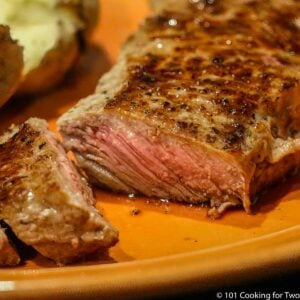
Pan Seared New York Strip Steak (Finish in Oven)
Video Slideshow
Ingredients
- 2 New York strip steaks - 1 inch thick
- salt and pepper to taste - or season to taste
Step-by-Step Instructions
Trim and season
- If you have time, allow the steaks to rest at room temperature for 30-60 minutes. Then, preheat the oven to 400° convection or 425° conventional.
- Trim any easily trimmable edge fat. Pat dry with paper towels. Season to your taste. A good sprinkle of black pepper and Kosher salt is all you need, but I use 7:2:2 (my homemade seasoning).
Pan sear for flavor
- Melt 1 tablespoon of butter or use oil in a cast iron or other oven-safe pan over medium-high heat. Some people prefer oil because of butter's lower smoke point, but I've never had issues with either.
- When hot, add the strip steaks and sear both sides for about 2 minutes, or until they reach your desired crust color.
Finish the steak in the oven
- Transfer the pan to a 400°F convection oven (or 425°F conventional). Roast to a few degrees below your final temperature—about 5–7 minutes for medium-rare (130°–135°), or 7–9 minutes for medium (140°–145°). Always check a few minutes early. (The variables are the steak thickness, how long you seared, and the actual oven temperature.)
Rest before serving
- Remove the pan from the oven, tent lightly with foil, and let the steaks rest for 5 minutes before serving to allow the juices to absorb back into the cells for maximum tenderness.
Recipe Notes
Pro Tips:
- Resting at room temperature before cooking helps steaks cook more evenly. Skip it if you must.
- I like to use 400°F convection, but other oven temps will work. Just adjust the cook time and remember: you’re cooking to temperature, not time.
- Trim excessive fat for better searing
- For the juiciest steak, season with salt right before searing or at least an hour ahead. Use the seasoning of your choice or some coarse salt and pepper. Marinades will also work well.
- Butter or oil both work; butter gives flavor, but oil has a higher smoke point.
- The internal temperature will rise a few degrees during resting after cooking.
- Always rest for at least 5 minutes before serving.
- NEVER cook by time alone. Use an instant-read thermometer to check doneness.
Your Own Private Notes
To adjust the recipe size:
You can adjust the number of servings above; however, only the amount in the ingredient list is adjusted, not the instructions.
Nutrition Estimate (may vary)
Editor's note: This article was originally published on February 20, 2015. It has been updated with expanded options, refreshed photos, and a table of contents to help with navigation.



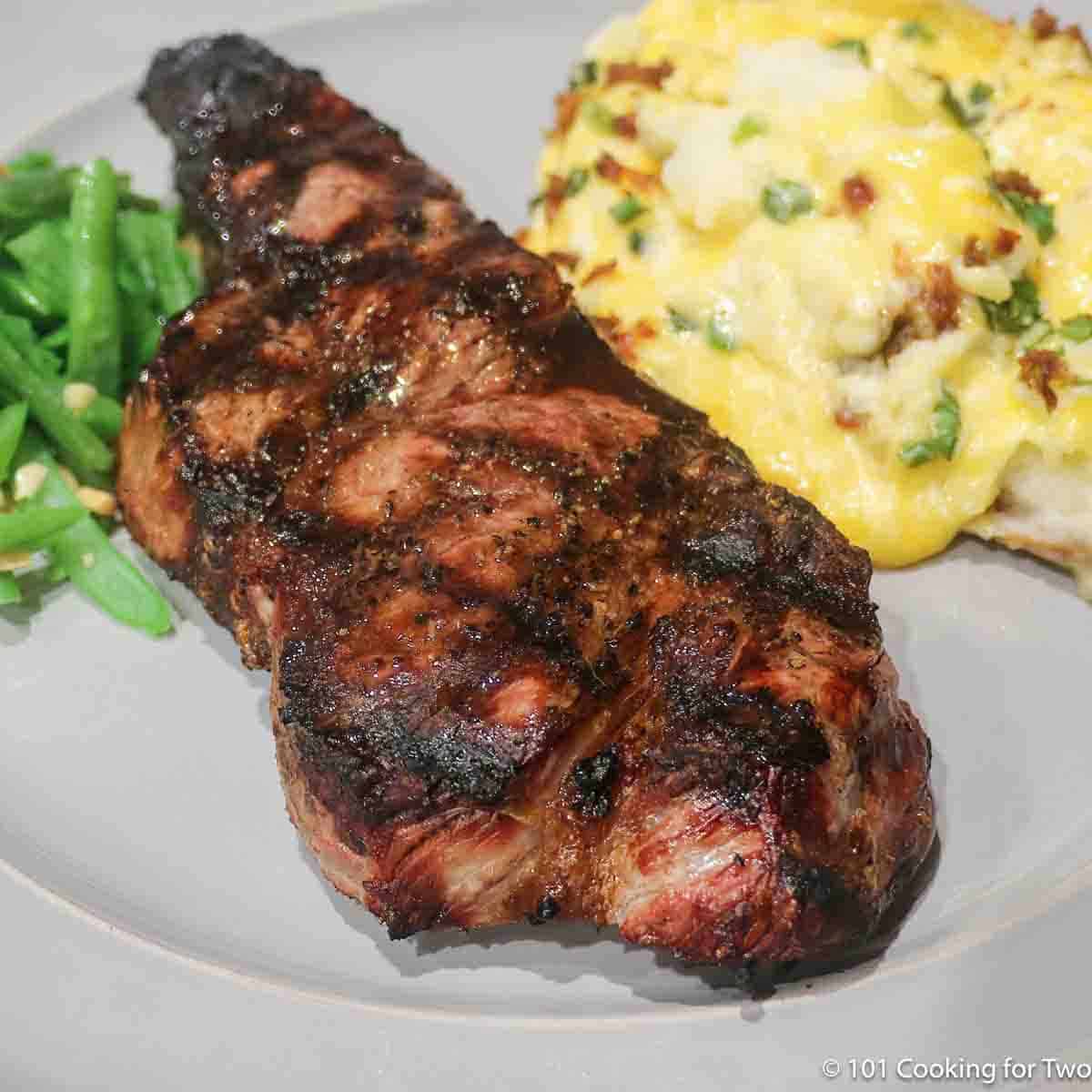

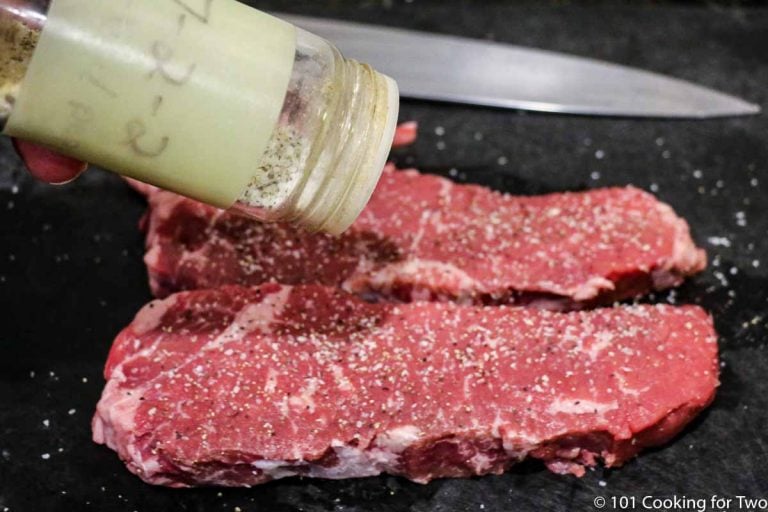
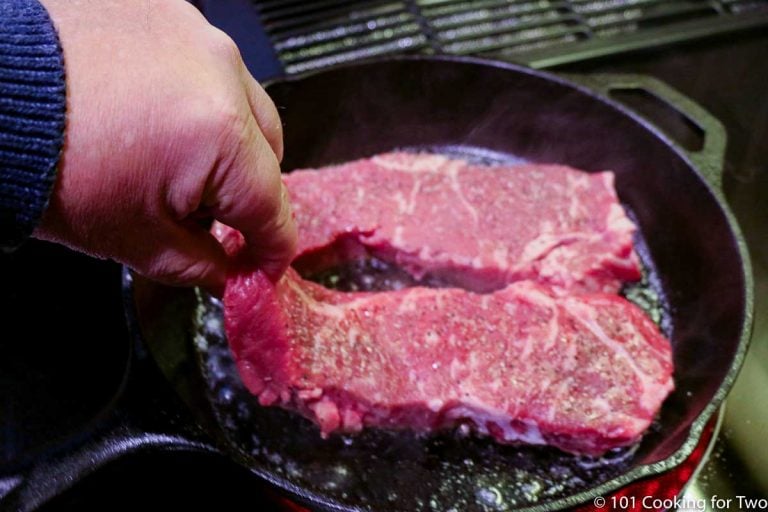
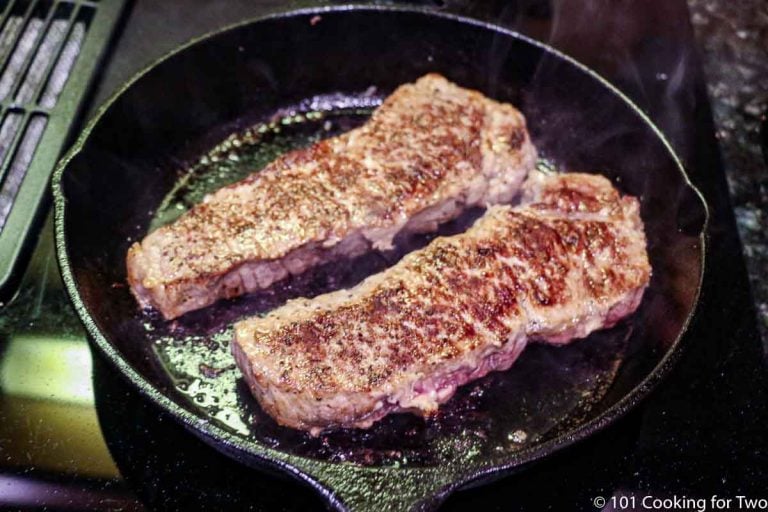
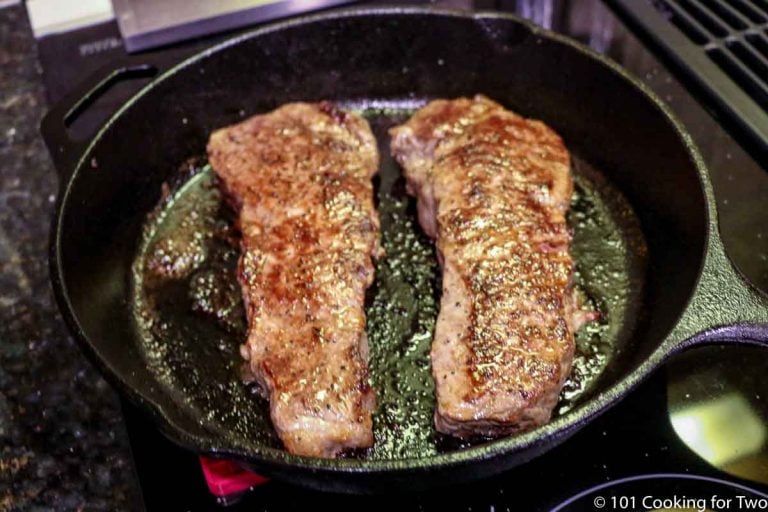
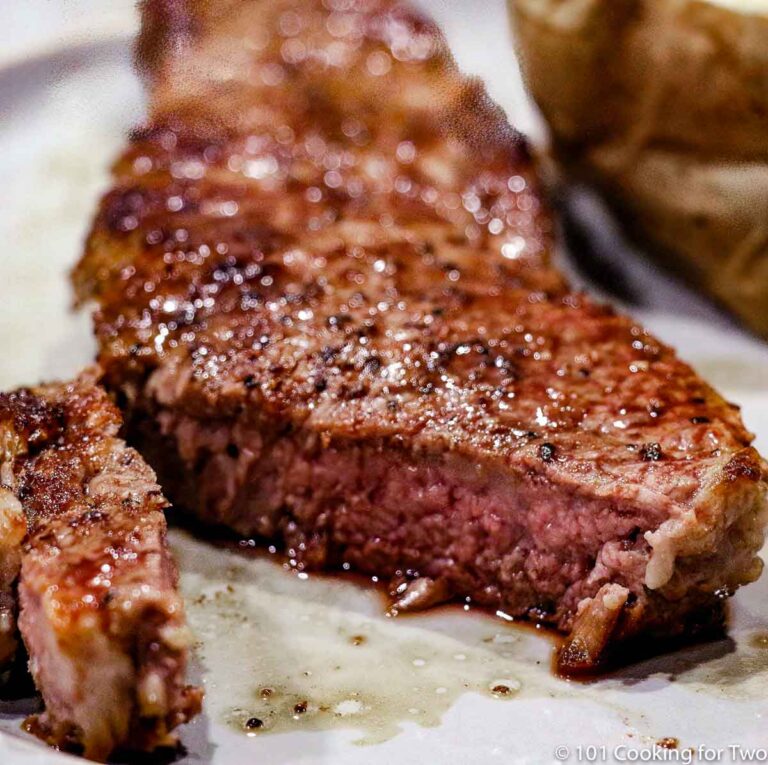

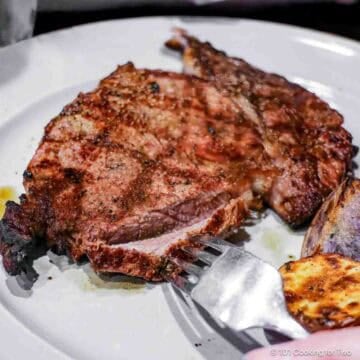
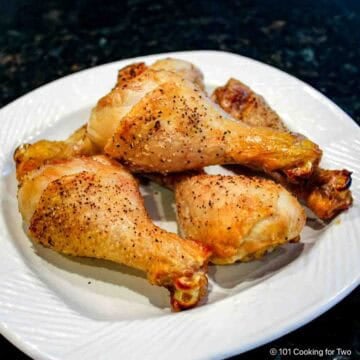

Dana says
I just want to say thank you for this easy simple recipe. It has been my go to for years now and it has NEVER failed me. I love simple food that’s delicious. I just wanted to say thank you for all the amazing steaks I’ve mastered through your guidance. ❤️
Dan Mikesell AKA DrDan says
Hi Dana,
Welcome to commenting. Always feel free to express yourself.
I'm so glad you are enjoying this and other recipes.
Thanks for the note and rating.
Dan
Julie Haske says
Followed these directions for a ribeye. Worked great, tasted yummy! Probably will have it again for Christmas Eve! Thanks again for another great recipe.
Bronzi says
I use this recipe constantly. So yummy may make tonight.
Jeff Willis says
Great recipe. Thanks. I've also done the reverse method cooking the steaks at low temp around 250 degrees in oven or indirect on grill . When the internal temp gets around 125 degrees sear in a cast iron skillet for 2-3 minutes per side.
Colleen says
I made this for my family tonight. I got 5 STARS from even the pickiest eater. I usually do this on the grill, but it is snowing in PA so I decided to give this a try. I used KerryGold butter and Montreal Steak Seasoning but cooked it exactly as suggested. It was AMAZING. Absolutely DELICIOUS! I will ONLY use this recipe from now on when I cook steak inside.
Patty says
One of the suggestions for any stove to oven recipe is to put the cast iron pan in the oven while doing the pre-heating. That way the pan is evenly heated before placing it on the stove. Saves the time & energy to heat the pan on the stove before searing the steaks as the pan is already hot and ready.
Elizabeth says
OMG, what an excellent suggestion!! Thank you so much!
Gail Vaughan says
Tried this recipe after I went to light our grill only to discover we were out of gas. Already had the steaks marinating and out at room temperature. I was skeptical but decided to give it a try. It was wonderful! Great option to grilled.
Kellia says
Trying this recipe tonight, but I have 2 different cuts of steak to cook. 2 New York strips, & 2 Porterhouses (all 1" thick). I'm wondering what the time difference will be in the oven for the PHouses, considering the bones..? Do you have advice on doing both at the same time? Can I just take the strips out to rest sooner and let the tbones go longer? How much longer would you guess? (We're aiming for med-rare to med on all).
Also! I don't have an oven safe skillet. Can I transfer to a large baking sheet instead? If so, shall I let it heat up in the oven while doing the stove top portion so it's preheated? Should I foil line it, or use racks above it?
Any advice welcome!!
Thank you in advance!
Dan Mikesell AKA DrDan says
Hi Kellia,
Welcome to the blog.
Not too big of a problem other than cooking that much size at one. T-bone/porterhouse steaks are mostly strip steaks. That big side is just a strip steak. The difference between the t-bone and the porterhouse is just the size of the meat on the other side of the bone which is tenderloin (filet)—bigger in the porterhouse.
I tend not to do this pan-searing method with bone-containing cuts since the meat will shrink some and the bone will prevent the area near it from searing. Not a big issue but that is why I usually grill my porterhouse steaks.
So assuming you don't care if a bit of the porterhouse does not sear much (the rest will sear and it all will cook fine), what are the issues you will face? The bone will delay the cooking slightly (not a lot) and the porterhouses probably are bigger overall. Lastly, the filet part of the porterhouse will overcook-it just tends to cook faster but that always happens and it can tolerate it and still be great.
So I would preheat the oven with a large sheet pan, sear the porterhouse first and transfer to the oven, then immediately sear the strip steaks (I assume you don't have a stovetop skillet large enough to do all four at once). Transfer the strips steaks and check the temp on the porterhouses (probably not done yet).
The porterhouse will probably be done first thanks to the headstart, move to a plate and tent with foil while the strips finish.
No rack or foil but you MUST use an instant-read thermometer to pull this off or you will be flying blind and most likely will crash. If you don't have one, they are about $10 at a big box store (Home Depot/Lowes, Walmart may or may not have one).
Good luck.
Dan
Sara says
Hello.. how long would I cook in the oven if the steak is 2 inches thick please?
Dan Mikesell AKA DrDan says
Hi Sara,
Welcome to the blog.
For extra thick cuts, it is a long discussion. Briefly, thick cuts should be rested to close to room temperature before starting. Seared and then the oven should be at a lower temp about 375° range. Lower because it will take longer to penetrate and you don't want to overcook the outside. Now the variables: exact thickness, the temperature of the meat when starting the sear, how much sear, the oven exact temp, the pan, you are getting the idea. This is why have have a pork chop and an extra thick pork chop recipes.
So no exact answer. Probably in the 15-20 minute range if I had a gun to my head. You MUST have an final internal temperature goal and a good instant read thermometer to monitor or you may have a disaster.
Hope that helped at least a litte.
Dan
John Del says
It always comes down to temp. I would pull them at 10 minutes in the oven and then take the temperature with a *quality* instant read thermometer. As they say, you can't uncook a steak. An oven safe digital thermometer like they sell on Amazon can keep track of the temperature on the fly. 145F for medium.
Paul Hassett says
Good morning. I was hoping to clarify a somewhat minor point with all of your stove to over recipes. I have used them all and they are phenomenal. My only question is that if I use the prescribed times, I am generally over. I wanted to ask - where is the over are you transferring the skillet to after searing (middle , bottom, etc)?
I have been using the middle rack, and am wondering if this may be the source of the inconsistency. Thank you for your time and sharing your recipes.
- yet another Dr / home chef
Dan Mikesell AKA DrDan says
Hi DrPaul,
Welcome to the blog. A great retirement hobby.
Oven racks should always be placed to keep the meat in the middle of the oven unless otherwise specified. So since the pan and meat are thin, in the middle.
Now about the variability, there are multiple possibilities, the temperature of the meat when you start searing, the thickness of the meat, the temperature of the pan, how much you sear, oven temperature, and the conductivity of heat of the pan(s). So as always cook by final internal temperature.
If your stovetop pan is oven safe, I don't transfer the meat to another pan. So I almost always use a $15 cast iron 10-inch skillet for these recipes. But most stovetop skillets are oven safe at reasonable temperatures. If you are not sure about your stovetop pan, a transfer to a known oven safe pan is in order.
We doctors are looking for reproducable results (that science thing). But think if all the variables and it is just "fuzzy logic," so go by endpoint only.
Hope that clarifies or at least doesn't muddy the water.
Dan
Cheryl says
DrDan, this recipe was a 10 out of 10. Perfection. I bought the prime NY Strips at Costco. I seared them for 3 minutes on each side in my cast iron skillet with butter, as you suggested, and finished them off in the oven at 425° for 9 minutes. They registered at 145°. We loved them. Thanks for the recipe!!!
Clarice says
Delicious! May not ever grill a steak again. This method is simple. No need to stand out at the grill in the middle of winter. Using oil and my fan on med - high : no smoke problem.
Betti J says
Tried this method of cooking steaks tonight. Came out perfect. Seared 2 minutes each side in my cast iron pan followed by 4 minutes in 400 degree oven. Used olive oil in skillet for searing. Best part was my smoke alarms did not go off.
Sharon says
Great recipe!! Perfectly delicious. I used butter in the pan and there was no smoking even in the oven. Can’t wait to make it again. How to get on your “cooking for two” Email list?
Thank you for the recipe forgot to say it in the beginning
Dan Mikesell AKA DrDan says
Hi Sharron,
Welcome to the blog.
Glad you enjoyed the recipe.
You will find email subscription links several places on the page but here is a direct link to my page that has the link at the top and explains what to expect and how to unsubscribe (super easy).
https://www.101cookingfortwo.com/subscribe
Thanks for the note, rating and interest.
Dan
Katherine Kelley says
Most excellent! My cast iron skillet is very small so cut the steak in half & turned out perfect, Thank you for all your recipes.